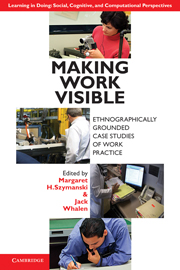Book contents
- Frontmatter
- Contents
- List of Figures and Excerpts
- List of Tables
- List of Contributors
- Series Foreword
- Foreword by John Seely Brown
- Acknowledgments
- Introduction
- Part I Work Practice Study in Historical Context
- Part II Applying Work Practice Methods
- 3 Uncovering the Unremarkable
- 4 Work Practices to Understand the Implications of Nascent Technology
- 5 Tokyo to Go
- Part III Practices around Documents
- Part IV The Customer Front
- Part V Learning and Knowledge Sharing
- Part VI Competency Transfer
- References
- Index
- LEARNING IN DOING: SOCIAL, COGNITIVE AND COMPUTATIONAL PERSPECTIVES
4 - Work Practices to Understand the Implications of Nascent Technology
Published online by Cambridge University Press: 05 August 2012
- Frontmatter
- Contents
- List of Figures and Excerpts
- List of Tables
- List of Contributors
- Series Foreword
- Foreword by John Seely Brown
- Acknowledgments
- Introduction
- Part I Work Practice Study in Historical Context
- Part II Applying Work Practice Methods
- 3 Uncovering the Unremarkable
- 4 Work Practices to Understand the Implications of Nascent Technology
- 5 Tokyo to Go
- Part III Practices around Documents
- Part IV The Customer Front
- Part V Learning and Knowledge Sharing
- Part VI Competency Transfer
- References
- Index
- LEARNING IN DOING: SOCIAL, COGNITIVE AND COMPUTATIONAL PERSPECTIVES
Summary
In 1992 social scientists and industrial and interface designers in Rochester, New York were presented with a unique opportunity to conduct a work practice study intended to identify and prioritize functionalities in a nascent technology. The place was the communications department of a multinational industrial mixer manufacturer and the technology was scanning.
Scanning? It held great promise, but there was little clarity about which features to develop first and how to build use cases, for example, stories, we could tell customers that would demonstrate why they needed to spend money and migrate from current equipment and update their existing ways of working. In other words, what did scanning bring to the party? Tangentially, but tellingly, this project also provides an example of ways in which the rich descriptions of work ethnographic inquiry differ from the possibly accurate but essentially inadequate understandings represented in standard “work flow.”
Fieldwork began at Sterling Manufacturers, based in upstate New York. Sterling, with satellite offices elsewhere in New York and field offices in 60 countries, made large, customized construction machinery. A write-up in their company's “World News” quarterly letter describes the project as it was presented to the world.
Since December of 1992 a “partnershipping” agreement has been going on between Sterling's Communications Department and Xerox's New Products/Systems Engineering Group. Xerox was in search of a manufacturing company who created, printed, stored, distributed, and retrieved a wide variety of documents using a combination of manual and automated systems. Sterling's Communication Department was seeking professional assistance to develop and implement more effective ways to perform the document services that they are responsible for. […]
- Type
- Chapter
- Information
- Making Work VisibleEthnographically Grounded Case Studies of Work Practice, pp. 74 - 86Publisher: Cambridge University PressPrint publication year: 2011

